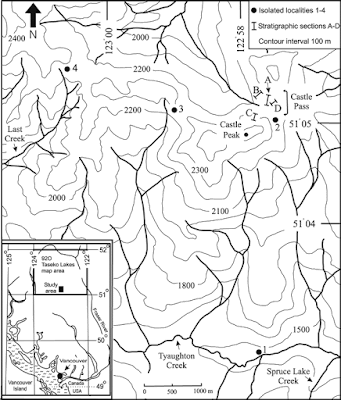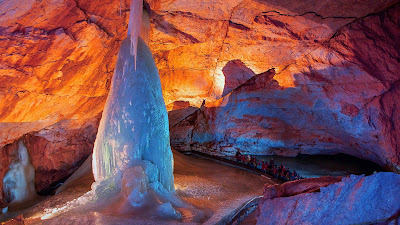The late Hettangian ammonite fauna from Taseko Lakes is diverse and relatively well‐preserved. Over three field seasons, thirty-five taxa from the Mineralense and Rursicostatum zones were studied and three new species discovered and named:
Fergusonites hendersonae,
Eolytoceras constrictum and
Pseudaetomoceras victoriense.
This material is very important as it greatly expands our understanding of the fauna and ranges of ammonites currently included in the North American regional ammonite zonation.
I had the very great honour of having the fellow below, Fergusonites hendersonae, a new species of nektonic carnivorous ammonite, named after me by palaeontologist Louse Longridge from the University of British Columbia.
I'd met Louise as an undergrad and was pleased as punch to hear that she would be continuing the research by Dr. Howard Tipper, the authority on this area of the Chilcotins and Haida Gwaii — which he dearly loved.
"Tip" was a renowned Jurassic ammonite palaeontologist and an excellent regional mapper who mapped large areas of the Cordillera. He made significant contributions to Jurassic paleobiogeography and taxonomy in collaboration with Dr. Paul Smith, Head of Earth and Ocean Science at the University of British Columbia.
Tip’s regional mapping within BC has withstood the test of time and for many areas became the regions' base maps for future studies. The scope of Tip’s understanding of Cordilleran geology and Jurassic palaeontology will likely never be matched. He passed away on April 21, 2005. His humour, knowledge and leadership will be sorely missed.
 |
Fergusonites hendersonae
|
Before he left us, he shared that knowledge with many of whom who would help to secure his legacy for future generations. We did several trips over the years up to the Taseko Lake area of the Rockies joined by many wonderful researchers from Vancouver Island Palaeontological Society and Vancouver Paleontological Society, as well as the University of British Columbia.
Both Dan Bowen and John Fam were instrumental in planning those expeditions and each of them benefited greatly from the knowledge of Dr. Howard Tipper.
If not for Tipper's early work in the region, our shared understanding and much of what was accomplished in his last years and after his passing would not have been possible.
Over the course of three field seasons, we endured elevation sickness, rain, snow, grizzly bears and very chilly nights — we were sleeping right next to a glacier at one point — but were rewarded by the enthusiastic crew, helicopter rides — which really cut down the hiking time — excellent specimens including three new species of ammonites, along with a high-spired gastropod and lobster claw that have yet to be written up. This area of the world is wonderful to hike and explore — stunningly beautiful country. We were also blessed with access as the area is closed to all fossil collecting except with a permit.
This fauna understanding helps us to understand the correlations between different areas: (1) the Mineralense and Rursicostatum zones are present in Taseko Lakes and can be readily correlated with contemporaneous strata elsewhere in North America; (2) the Mineralense and Rursicostatum zones of North America are broadly equivalent to the Canadensis Zone and probably the Arcuatum horizon of the South American succession; (3) broad correlations are possible with middle–late Hettangian and earliest Sinemurian taxa in New Zealand; (4) the Mineralense and Rursicostatum zones are broadly equivalent to the circum‐Mediterranean Marmoreum Zone; (5) the Mineralense Zone and the lower to middle portion of the Rursicostatum Zone are probably equivalent to the Complanata Subzone whereas the upper portion of the Rursicostatum Zone may equate to the Depressa Subzone of the north‐west European succession.
 |
Taseko Lake Area, BC
|
The Taseko Lakes area has yielded the best preserved and most diverse collection of late Hettangian ammonites yet discovered in British Columbia (BC). Early studies of the fauna were undertaken by Frebold (1951, 1967). At that time, eastern Pacific ammonite faunas were poorly understood and species were frequently shoehorned into established north‐west European taxa.
Since then, knowledge of eastern Pacific Hettangian ammonite faunas has improved considerably.
Detailed systematic studies have been completed on faunas from localities in other areas of BC, Alberta, Alaska, Oregon, Nevada, Mexico and South America (e.g. Guex 1980, 1995; Imlay 1981; Hillebrandt 1981, 1988, 1990, 1994, 2000a–d; Smith and Tipper 1986; Riccardi et al. 1991; Jakobs and Pálfy 1994; Pálfy et al. 1994, 1999; Taylor 1998; Hall et al. 2000; Taylor and Guex 2002; Hall and Pitaru 2004).
These studies have demonstrated that Early Jurassic eastern Pacific ammonites had strong Tethyan affinities as well as a high degree of endemism (Guex 1980, 1995; Taylor et al. 1984; Smith et al. 1988; Jakobs et al. 1994; Pálfy et al. 1994). Frebold’s early studies were also hampered because they were based on small collections, which limited understanding of the diversity of the fauna and variation within populations. However, recent mapping has greatly improved our understanding of the geology of Taseko Lakes (Schiarizza et al. 1997; Smith et al. 1998; Umhoefer and Tipper 1998) and encouraged further collecting that has dramatically increased the size of the sample.
A study of the ammonite fauna from Taseko Lakes is of interest for several reasons. The data are important for increasing the precision of the late Hettangian portion of the North American Zonation.
Owing to the principally Tethyan or endemic nature of Early Jurassic ammonites in the eastern Pacific, a separate zonation for the Hettangian and Sinemurian of the Western Cordillera of North America has been established by Taylor et al. (2001). Except for information available from the early studies by Frebold (1951, 1967), the only Taseko Lakes taxa included in the North American Zonation of Taylor et al. (2001) were species of Angulaticeras studied by Smith and Tipper (2000).
Since then, Longridge et al. (2006) made significant changes to the zonation of the late Hettangian and early Sinemurian based on a detailed study of the Badouxia fauna from Taseko Lakes (Text‐fig. 2). An additional taxonomic study was recently completed on the late Hettangian ammonite Sunrisites (Longridge et al. 2008) and this information has not yet been included within the zonation.
 |
Hettangian Zonation
|
The systematics of the remaining ammonite fauna from Taseko Lakes are presented here. A comprehensive study of this material is important because the exceptional quality and diversity of the fauna provide important data for updating the North American Zonation, making it more comprehensive and more widely applicable, especially in Canada.
The Taseko Lakes fauna can improve Hettangian correlations within North America as well as between North America and the rest of the world.
North‐west European ammonite successions (e.g. Dean et al. 1961; Mouterde and Corna 1997; Page 2003) are considered the primary standard for Early Jurassic biochronology (Callomon 1984).
In north‐west Europe, the turnover from schlotheimiid dominated faunas in the late Hettangian to arietitid dominated faunas in the early Sinemurian was sharp (e.g. Dean et al. 1961; Bloos 1994; Bloos and Page 2002). In other areas, by contrast, these faunas were not so mutually exclusive and the transition was much more gradual.
This makes correlations between north‐west Europe and other areas difficult (e.g. Bloos 1994; Bloos and Page 2000, 2002). Correlations are further impeded by endemism and provincialism.
The Taseko Lakes fauna addresses these problems because it contains many taxa that are common throughout the eastern Pacific as well as several cosmopolitan taxa that make intercontinental correlation possible. Correlation between North America and other areas is of particular significance in that the interbedded volcanic and fossiliferous marine rocks in North America permit the calibration of geochronological and biochronological time scales (Pálfy et al. 1999, 2000).
This correlation between the late Hettangian fauna in the Taseko Lakes area and contemporaneous faunas in other areas of North America, South America, New Zealand, western and eastern Tethys, and north‐west Europe is of particular interest to me — especially the correlation of the faunal sequences of Nevada, USA.
Reference: PaleoDB 157367 M. Clapham GSC C-208992, Section A 09, Castle Pass Angulata - Jurassic 1 - Canada, Longridge et al. (2008)
L. M. Longridge, P. L. Smith, and H. W. Tipper. 2008. Late Hettangian (Early Jurassic) ammonites from Taseko Lakes, British Columbia, Canada. Palaeontology 51:367-404
PaleoDB taxon number: 297415; Cephalopoda - Ammonoidea - Juraphyllitidae; Fergusonites hendersonae Longridge et al. 2008 (ammonite); Average measurements (in mm): shell width 9.88, shell diameter 28.2; Age range: 201.6 to 196.5 Ma. Locality info: British Columbia, Canada (51.1° N, 123.0° W: paleo coordinates 22.1° N, 66.1° W)
Photo One: Hettangian Ammonites and Gastropods, Taseko Lakes. Photo Two: Fergusonites hendersonae, a Late Hettangian (Early Jurassic) ammonite from the Taseko Lakes area of British Columbia, Canadian Rockies, named by Dr. Louise Longridge after Heidi Henderson, Chair, Vancouver Paleontological Society who collected and subsequently donated many Hettangian specimens from Taseko Lakes to the GSC collections. Holotype. GSC 127423 from the Rursicostatum Zone, Castle Pass section A, level 06, Taseko Lakes.
Map: Localities of sections and isolated outcrops bearing late Hettangian ammonites in the Taseko Lakes map area. Figure Two: Zonation for the Hettangian showing correlation of North American zones with South America, north‐west Europe, western Tethys (circum‐Mediterranean), eastern Tethys and New Zealand. Only approximate correlations are implied.



































